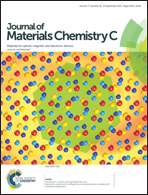Light blue and green thermally activated delayed fluorescence from 10H-phenoxaborin-derivatives and their application to organic light-emitting diodes†
Abstract
New luminescent compounds consisting of 10H-phenoxaboryl groups as electron-accepting units and carbazole (9), 9,9-dimethylacridane (10), or phenoxazine (11) as an electron-donating unit have been synthesized. Compounds 10 and 11 showed thermally activated delayed fluorescence (TADF) with light blue and green emissions, respectively, with very high PL quantum yields (PLQYs), however, compound 9 exhibited only a prompt emission and no delayed component. Photoluminescence studies and quantum chemical calculation based on density functional theory (DFT) and time-dependent density functional theory (TD-DFT) revealed that in comparison with compound 9, the HOMO and LUMO for compounds 10 and 11 are well separated, resulting in lowering of ΔEST and effective reverse intersystem crossing (RISC) between a lowest triplet excited state (T1) and a lowest singlet excited state (S1). Organic light-emitting diodes (OLEDs) using compounds 10 and 11 exhibited light blue and green emissions with very good maximum ηext of 15.1% and 22.1%, respectively.


 Please wait while we load your content...
Please wait while we load your content...